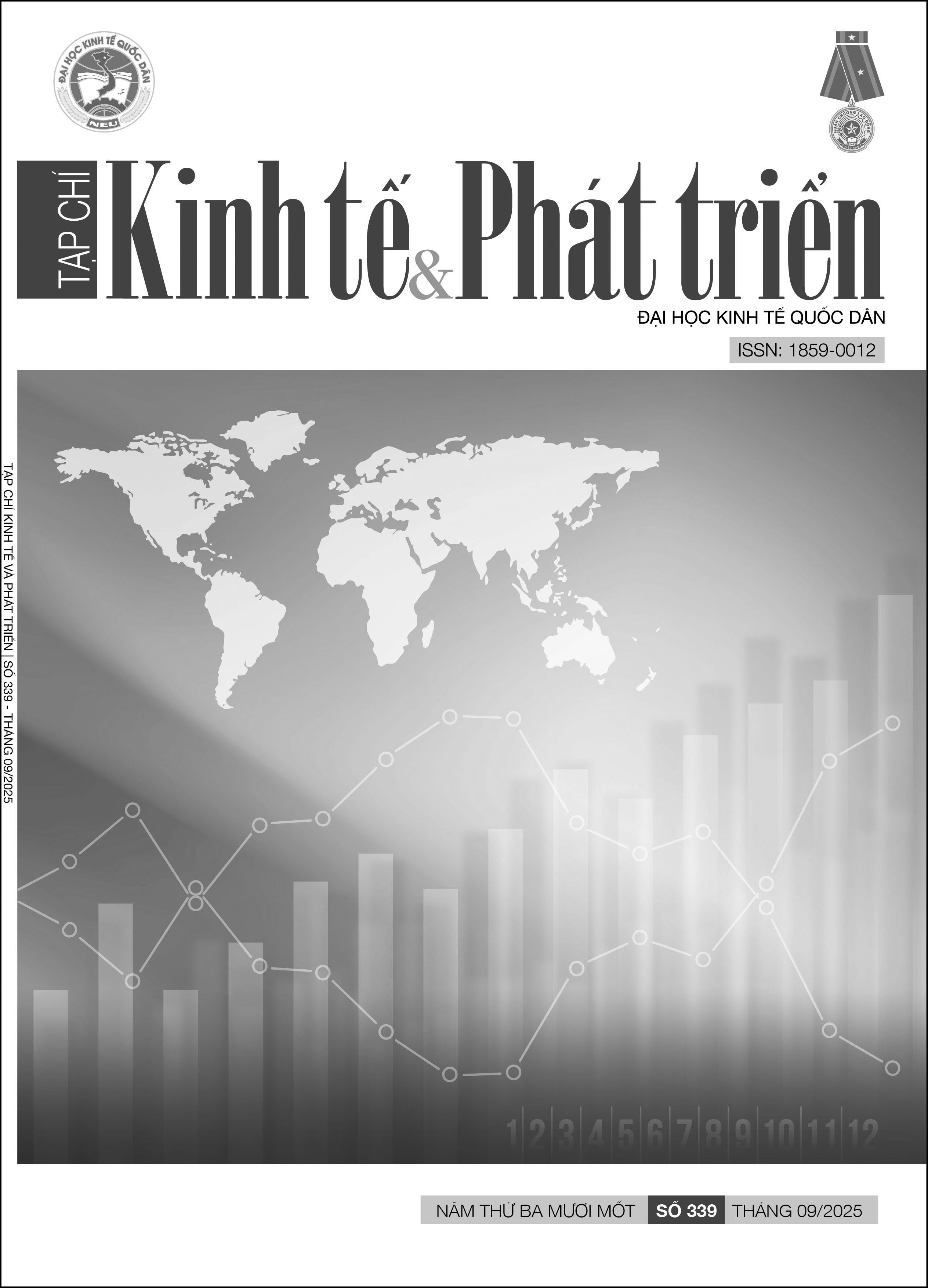Vai trò của truyền thông nội bộ đối xứng và đầu tư quan hệ trong việc tạo dựng hành vi ủng hộ doanh nghiệp của nhân viên
DOI:
https://doi.org/10.33301/JED.VI.2573Từ khóa:
đầu tư quan hệ, hành vi ủng hộ doanh nghiệp của nhân viên, truyền thông nội bộ đối xứngTóm tắt
Dựa trên lý thuyết trao đổi xã hội, nghiên cứu này tập trung khám phá vai trò của truyền thông nội bộ đối xứng và đầu tư quan hệ với hành vi ủng hộ doanh nghiệp của nhân viên. Dữ liệu được thu thập từ 279 nhân viên đang làm việc tại các doanh nghiệp công nghệ thông tin ở Hà Nội và được phân tích bằng phương pháp PLS-SEM. Kết quả nghiên cứu cho thấy cả truyền thông nội bộ đối xứng và đầu tư quan hệ đều có ảnh hưởng tích cực và có ý nghĩa thống kê đến hành vi ủng hộ doanh nghiệp của nhân viên. Đặc biệt, đầu tư quan hệ đóng vai trò trung gian trong mối quan hệ giữa truyền thông nội bộ đối xứng và hành vi ủng hộ doanh nghiệp. Từ những phát hiện này, nghiên cứu đề xuất rằng để thúc đẩy hành vi ủng hộ doanh nghiệp, các tổ chức cần xây dựng và duy trì các mối quan hệ nội bộ dựa trên sự đối thoại, bình đẳng và cam kết hai chiều giữa nhân viên và doanh nghiệp.
Tài liệu tham khảo
Barclay, D., Higgins, C. & Thompson, R. (1995). The partial least squares (PLS) approach to causal modeling: personal computer adoption and use as an Illustration. Technology Studies, 2, 285-309.
Bender-Samuel, P. (2022). Spiking Attrition Impact On IT And Engineering Services. Retrieved on May 31, 2022, from https://www.forbes.com/sites/peterbendorsamuel/2022/05/31/spiking-attrition-impact-on-it-and-engineering-services.
Blau, P. (1964). Exchange and Power in Social Life. Routledge, New York: Wiley.
Bộ Thông tin và Truyền thông (2024). Sách trắng Công nghệ thông tin và truyền thông Việt Nam 2023. NXB Thông tin và truyền thông, Việt Nam.
Cohen, J. (1988). Statistical Power Analysis for the Behavioral Sciences. L. Erlbaum Associates, New Jersey.
Cropanzano, R. & Mitchell, M. S. (2005). Social exchange theory: An Interdisciplinary review. Journal of Management, 31(6), 874–900. https://doi.org/10.1177/0149206305279602.
De Wulf, K., Odekerken-Schröder, G. & Iacobucci, D. (2001). Investments in Consumer Relationships: A Cross-Country and Cross-Industry Exploration. Journal of Marketing, 65(4), 33–50. https://doi.org/10.1509/jmkg.65.4.33.18386.
Fornell, C. & Larcker, D. F. (1981). Evaluating structural equation models with unobservable variables and measurement error. Journal of Marketing Research, 18(1), 39–50. https://doi.org/10.1177/002224378101800104.
Frank, J. (2015). From engagement to empowerment – employee advocacy in the social economy. Strategic HR Review, 14(4). https://doi.org/10.1108/SHR-06-2015-0047.
Grunig, J.E. (1992), Symmetrical systems of internal communication. In Grunig, J.E., Dozier, D.M., Ehling, W.P., Grunig, L.A., Repper, F.C. & White, J. (Eds), Excellence in Public Relations and Communication Management. Lawrence Erlbaum, Hillsdale, NJ.
Hair, J. F., Risher, J. J., Sarstedt, M. & Ringle, C. M. (2019). When to use and how to report the results of PLS-SEM. European Business Review, 31(1), 2–24. https://doi.org/10.1108/EBR-11-2018-0203.
Henseler, J., Ringle, C. M. & Sarstedt, M. (2015). A new criterion for assessing discriminant validity in variance-based structural equation modeling. Journal of the Academy of Marketing Science, 43, 115–135. https://doi.org/10.1007/s11747-014-0403-8.
Khanna, S. & Prusty, T. (2024). Diversity-oriented leadership (DOL) as a predictor of employee advocacy (EA) in select fortune Indian companies: mediating effects of symmetrical internal communication (SIC) and work engagement (WE). Cogent Business and Management, 11(1). https://doi.org/10.1080/23311975.2024.2377768.
Kim, J. N. & Rhee, Y. (2011). Strategic thinking about employee communication behavior (ECB) in public relations: Testing the models of megaphoning scouting effects in Korea. Journal of Public Relations Research, 23(3), 243–268. https://doi.org/10.1080/1062726X.2011.582204.
Kim, Y. & Meganck, S. (2025). Fostering employee support for corporate social advocacy (CSA) through dialogic internal communication and transformational leadership. Journal of Public Relations Research, 37(1-2), 189-208.
Kock, N. (2015). Common method bias in PLS-SEM: A full collinearity assessment approach. International Journal of E-Collaboration, 11(4), 1–10. https://doi.org/10.4018/ijec.2015100101.
Lee, Y. & Kim, K. H. (2021). Enhancing employee advocacy on social media: the value of internal relationship management approach. Corporate Communications, 26(2), 311–327. https://doi.org/10.1108/CCIJ-05-2020-0088.
Men, L. R. & Stacks, D. (2014). The Effects of Authentic Leadership on Strategic Internal Communication and Employee-Organization Relationships. Journal of Public Relations Research, 26(4), 301–324. https://doi.org/10.1080/1062726X.2014.908720.
Men, L. R. & Sung, Y. (2022). Shaping Corporate Character Through Symmetrical Communication: The Effects on Employee-Organization Relationships. International Journal of Business Communication, 59(3), 427–449. https://doi.org/10.1177/2329488418824989.
Men, L. R. & Vercic, A. T. (2021). Current Trends and Issues in Internal Communication. Springer International Publishing, Switzerland.
Men, L. R. & Yue, C. A. (2019). Creating a positive emotional culture: Effect of internal communication and impact on employee supportive behaviors. Public Relations Review, 45(3). https://doi.org/10.1016/j.pubrev.2019.03.001.
Men, L. R. (2014). Why Leadership Matters to Internal Communication: Linking Transformational Leadership, Symmetrical Communication, and Employee Outcomes. Journal of Public Relations Research, 26(3), 256–279. https://doi.org/10.1080/1062726X.2014.908719.
Thelen, P. D. & Formanchuk, A. (2022). Culture and internal communication in Chile: Linking ethical organizational culture, transparent communication, and employee advocacy. Public Relations Review, 48(1). https://doi.org/10.1016/j.pubrev.2021.102137.
Thelen, P. D. & Men, L. R. (2023). Commentary: The Role of Internal Communication in Fostering Employee Advocacy: An Exploratory Study. International Journal of Business Communication, 60(4), 1441–1454. https://doi.org/10.1177/2329488420975832.
Thelen, P. D. (2020). Internal communicators’ understanding of the definition and importance of employee advocacy. Public Relations Review, 46(4). https://doi.org/10.1016/j.pubrev.2020.101946.
Tremblay, M. & Landreville, P. E. (2015). Information sharing and citizenship behaviors: Mediating the roles of empowerment, procedural justice, and perceived organizational support. International Journal of Business Communication, 52(4), 347–368. https://doi.org/10.1177/2329488414525459.





